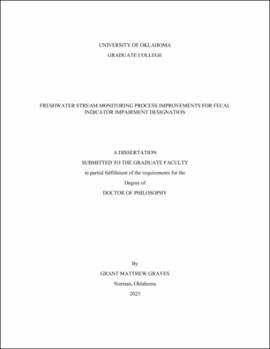| dc.description.abstract | Recreational water quality standards for freshwater streams and rivers are important to understand the potential human health risks associated with primary body contact recreation. Indicator bacteria, Enterococcus and Escherichia coli, are used to routinely monitor and assess waterbodies for impairment. The 2020 Clean Water Act 303(d) Integrated Report indicates that approximately 7500 miles of streams and rivers are impaired for both E. coli and Enterococcus in Oklahoma. Fecal indicator bacteria (FIB) sources are often difficult to assess as they are from numerous anthropogenic, wildlife and environmental non-point sources and require consistent monitoring and assessment due to potential dynamic spatial and temporal factors within streams. The Oklahoma water quality standards provide threshold criteria and a general sampling frequency for FIB to make an impairment assessment, but do not provide guidelines for how, when, or where water samples should be collected in a waterbody. Furthermore, there is evidence from recent studies to suggest that Enterococcus may not be the strongest predictor for freshwater impairment criteria and may be of non-enteric origin and that fluorogenic substrate methods (i.e., Enterolert™ [ELT]) used to analyze Enterococcus samples may result in false positives. Resources are often limited for many agencies that routinely monitor these streams and new approaches and tools are needed to develop effective monitoring plans. Given the immense resource effort required to monitor and assess these streams, more research is needed to understand and improve the FIB monitoring process for primary body contact recreation assessment. Therefore, the objectives of this dissertation were to 1) evaluate spatial and temporal factors in Oklahoma streams that may influence FIB, 2) investigate stream sediment as a contributing factor to Enterococcus in streams and rivers, 3) evaluate the ELT enumeration method for applicability to analyze freshwater stream samples for Enterococcus, and 4) explore existing geospatial and water quality data to develop correlation factors and regression equations to improve prediction of FIB for monitoring and assessment.
Studies that were conducted in this dissertation included a 1) field water quality spatiotemporal study at two cross sections in Spring Creek (Ch. 2), 2) spatiotemporal assessment of six streams and two laboratory microcosms for Enterococcus survivability in sediment and water and related environmental factors (Ch. 3), 3) investigation of the ELT method for Enterococcus false positives from stream water and sediment samples (Ch. 4), and 4) development of multiple linear regressions for FIB using water quality monitoring data collected from the Oklahoma Conservation Commission (Ch. 5). In brief, the results of these studies revealed that spatial and temporal factors (i.e., sampling location and time) and water quality and geographical characteristics (i.e., land use) can influence FIB in Oklahoma streams (Ch. 2 and Ch. 3). Furthermore, these spatiotemporal factors can be used to predict FIB concentrations in stream water and sediment (Ch. 3). Enterococcus showed extended survival and stability in stream sediments greater than 31-d under stable laboratory microcosms (Ch. 3). False positive bacteria were identified in 25% of all ELT samples analyzed with greater than 90% of those identified as Paenibacillus spp. from the microcosm and field studies (Ch. 4). Regression equations can be developed from water quality and geospatial variables to provide an initial reconnaissance of the expected FIB concentrations within a stream and/or region (Ch. 5). The outcomes of this work indicate that more emphasis should be placed on evaluation of the sampling process design and methodology for assessing Oklahoma streams for FIB impairment determination. | en_US |

